Blog
June 16th, 2014
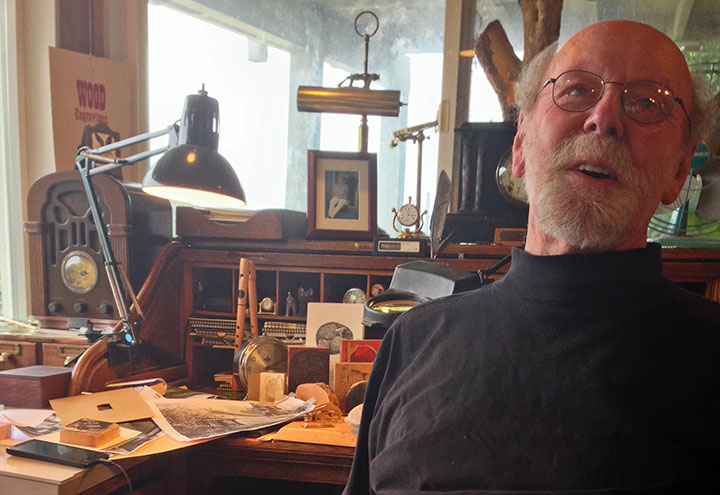
This is my friend Carl.
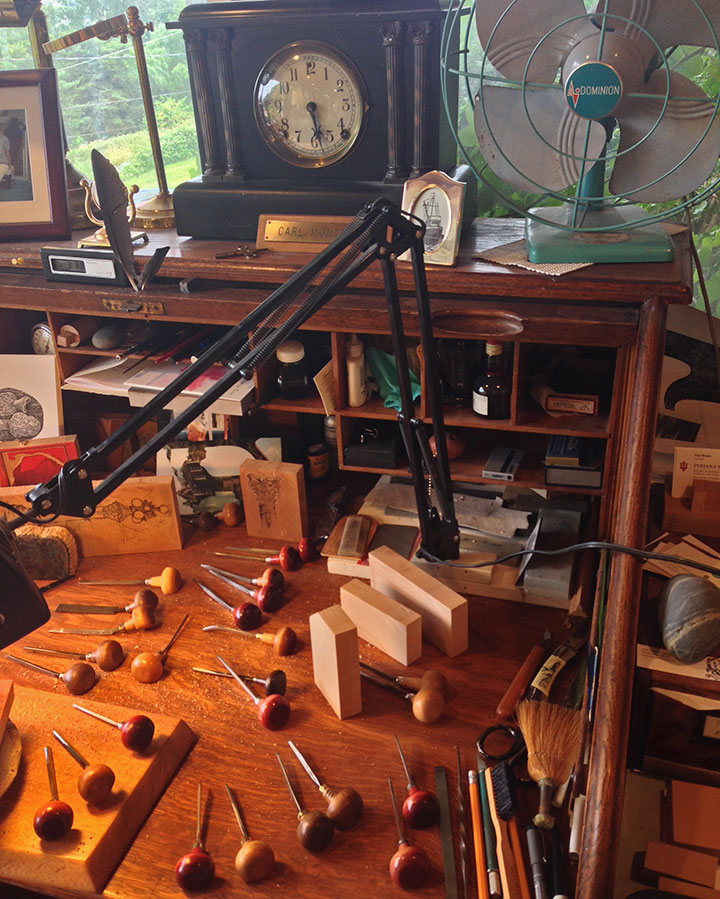
He’s a wood engraver extraordinaire—
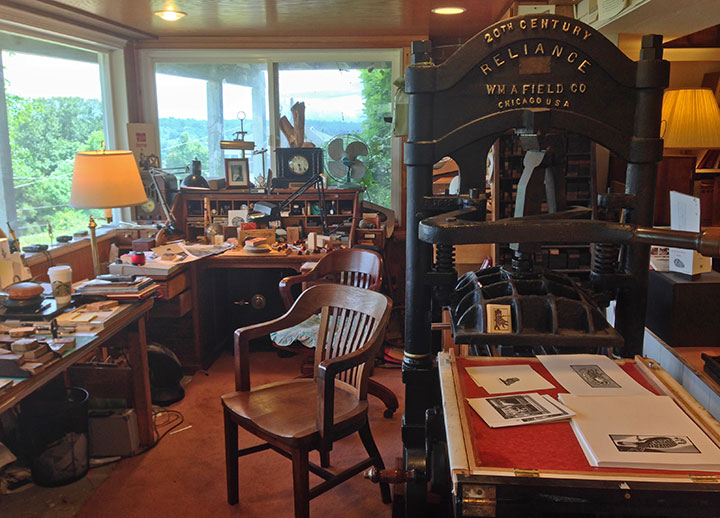
—and his West Seattle letterpress studio is a thing of beauty.

He does lovely, painstaking work (those are his engravings on the wall there), and he runs a tight ship at that studio of his.

Which is why my friend Mary-Alice called on Carl when she picked up a vintage Adana flatbed press, and wanted help whipping it into shape. She and her husband were planning to bring the press to West Seattle yesterday. I’d never seen an Adana in action before (I’m more of a Vandercook gal myself), so I asked to tag along.

Carl was more than ready for us.
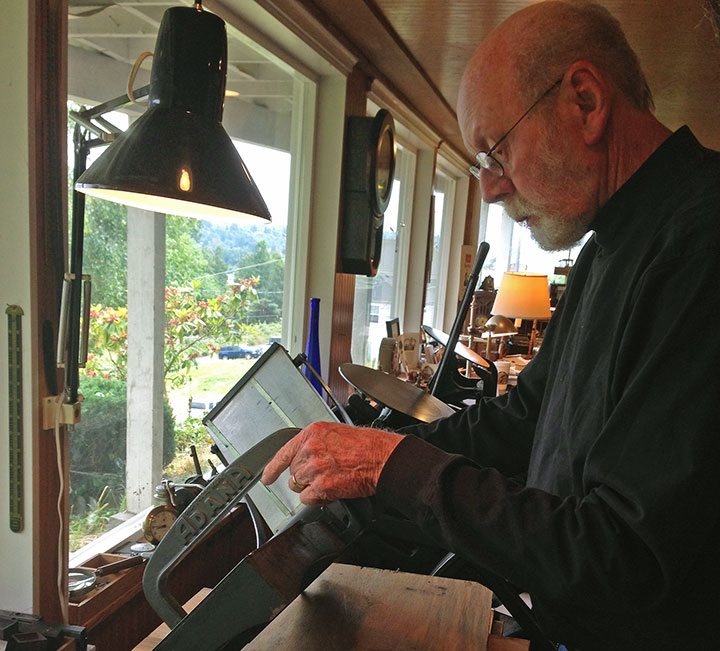
He gave the press a quick once-over. “I think you’re getting off too easy, Mary-Alice,” he said. “There aren’t even any spiders under here!”
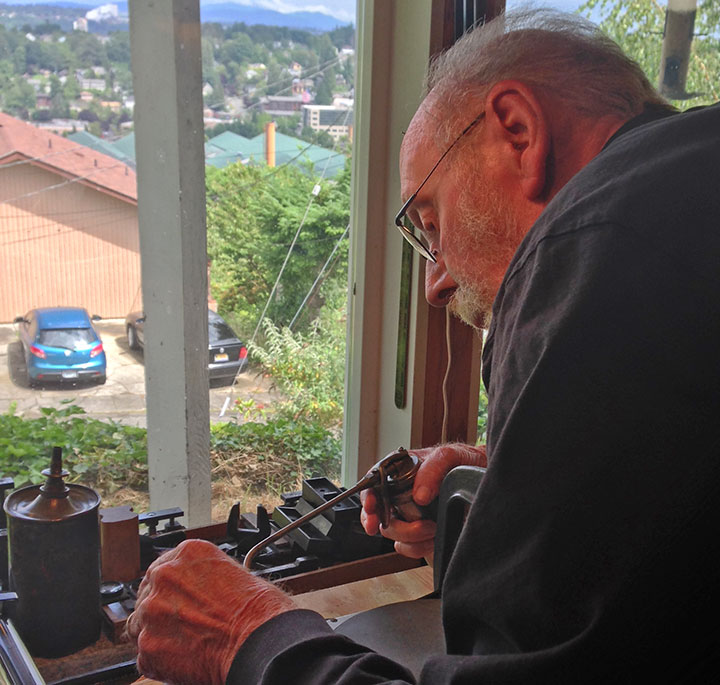
A few drops of oil,
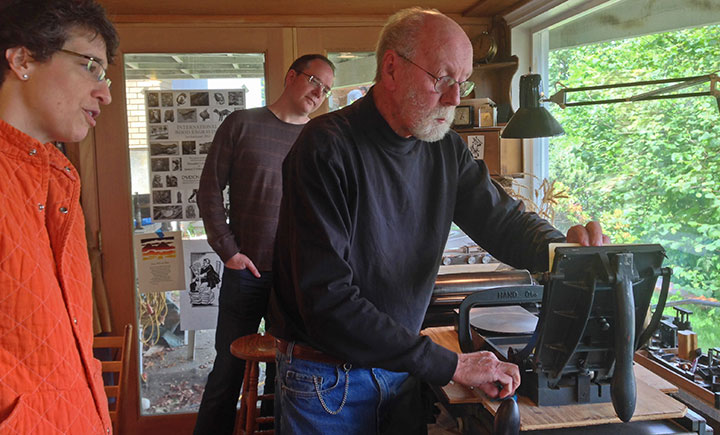
some careful adjustments,
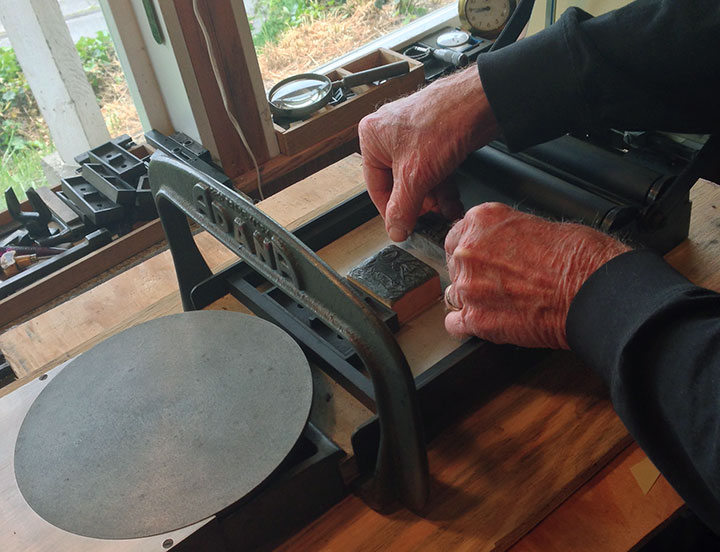
one of Carl’s own engravings to use as a test,
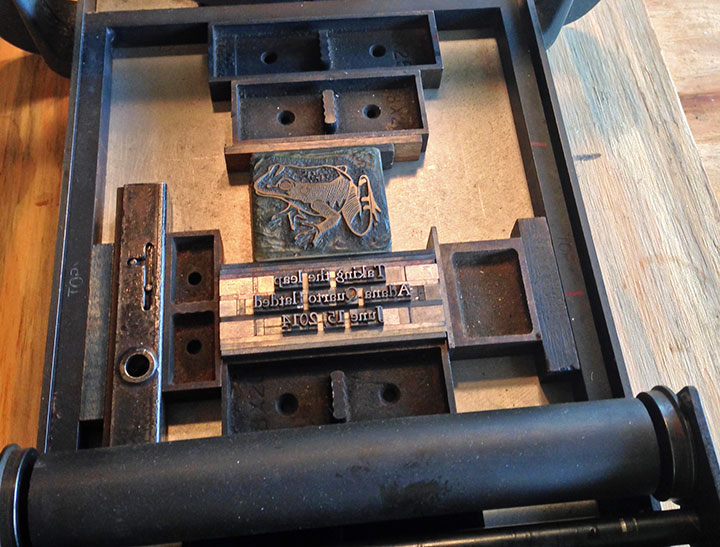
and a little text M-A set from his massive collection of type—and all of a sudden the Adana was print-ready.

Carl even broke out the fancy handmade paper—”This is an important occasion!” he said.
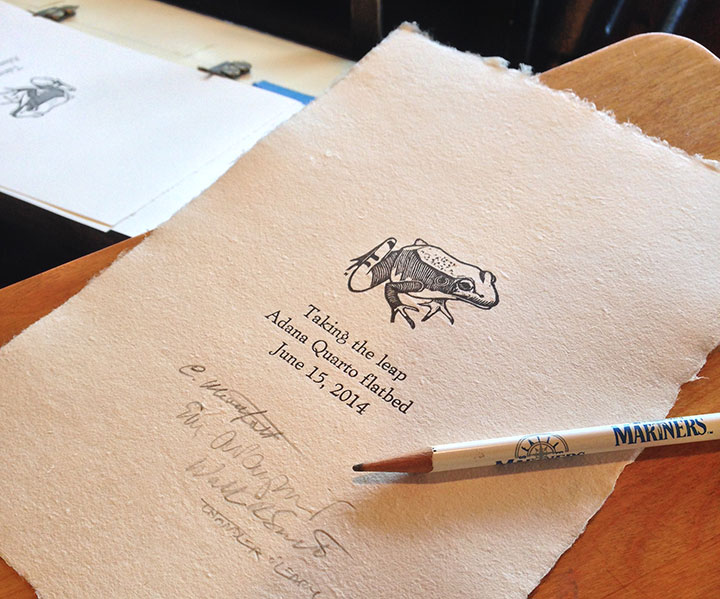
Pretty darn good results, if you ask me. Carl made us all sign the finished broadside. (Mariners pencil for the win!)
“How come I get to sign?” I asked, confused.
Carl chuckled and said, “You documented the occasion. Sign it!”
Aye, aye, Captain!
March 18th, 2014
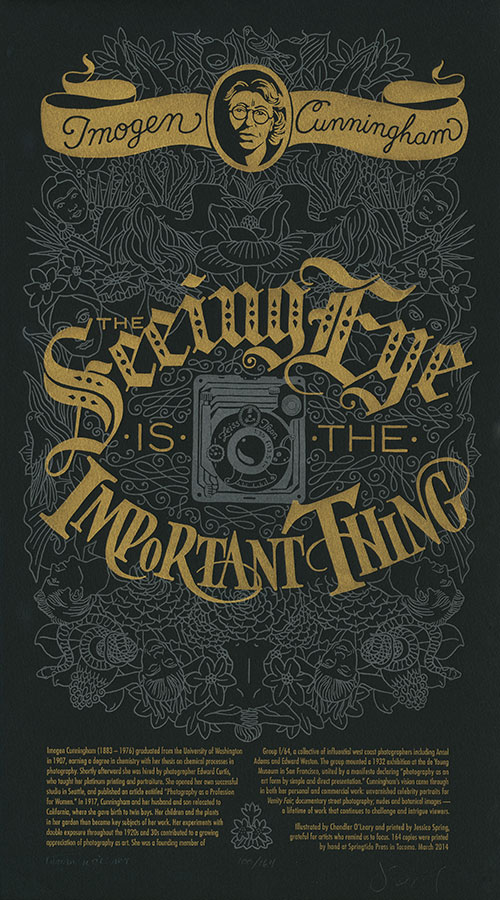
If you earn your living by drawing pictures, you have to spend a lot of time with your head down and your eyes on your paper. Yet at this time of year, with spring coming along fast (at least in the Northwest…), life hurries by at a frantic pace. I hate the idea of missing any of it—so I’m always happy for any reminder to stop and really look around me. So for our newest Dead Feminist broadside, we’re heeding the words of one of America’s greatest photographers:
The seeing eye is the important thing. — Imogen Cunningham
This piece is a major departure from what we’ve done in the past—as you can plainly see. For the first time ever we’ve printed the broadside on black paper—which helped us “pull the focus” (if you will) onto the quote. It also provided a beautiful backdrop for a tribute to someone who spent her life creating black-and-white images.
Surrounding the quote is an intricate metallic silver filigree of spring botanicals and portraiture, creating a pastiche of the subjects of some of Imogen Cunningham’s most iconic photographs—while the color choice references the traditional silver-gelatin photographic process. In the eye of the storm of imagery is the all-seeing camera lens, looking out onto the world.

Jessica has her own secret-sauce recipe for gold ink, and while we’ve used it before in our series (like in Gun Shy), nothing makes it look so fabulous as a dark background. The gold ink looked amazing on press—we kind of wished we could just leave the ink on there permanently, because that’s some serious bling. (It almost made the Vandercook feel like some sort of super-cool Bond gadget.)
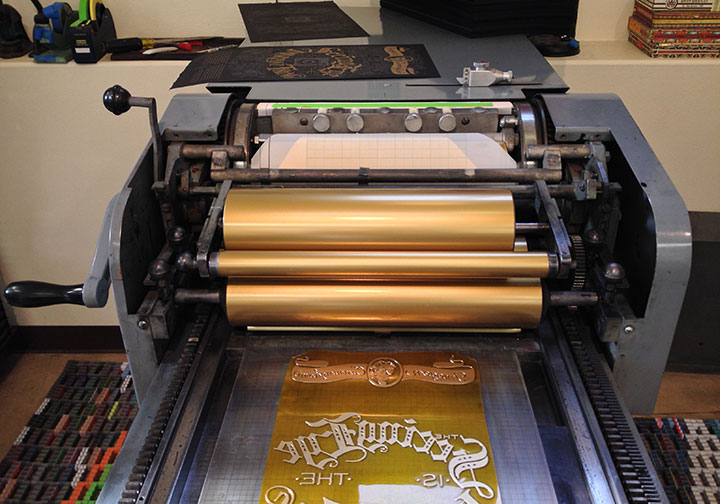
As always, we donate a portion of the proceeds of the series to a nonprofit that aligns with the message of each piece. To help sharpen the seeing eyes of the artists of tomorrow, this time we’ve chosen Youth in Focus — a nonprofit that puts cameras in the hands of at-risk youth to “teach them how to develop negatives into positives.”
• • • • • • • • • • • • • • • • • • • • • • • • • • • • • • • • • • • • • • • • • • • • • • • • • • • • • • • • • • • •
Focal Point: No. 19 in the Dead Feminists series
Edition size: 164
Poster size: 10 x 18 inches
Printed on an antique Vandercook Universal One press, on archival, 100% rag (cotton) paper. Each piece is numbered and signed by both artists.
Colophon reads:
Imogen Cunningham (1883 – 1976) graduated from the University of Washington in 1907, earning a degree in chemistry with her thesis on chemical processes in photography. Shortly afterward she was hired by photographer Edward Curtis, who taught her platinum printing and portraiture. She opened her own successful studio in Seattle, and published an article entitled “Photography as a Profession for Women.” In 1917, Cunningham and her husband and son relocated to California, where she gave birth to twin boys. Her children and the plants in her garden then became key subjects of her work. Her experiments with double exposure throughout the 1920s and 30s contributed to a growing appreciation of photography as art. She was a founding member of Group f/64, a collective of influential west coast photographers including Ansel Adams and Edward Weston. The group mounted a 1932 exhibition at the de Young Museum in San Francisco, united by a manifesto declaring “photography as an art form by simple and direct presentation.” Cunningham’s vision came through in both her personal and commercial work: unvarnished celebrity portraits for Vanity Fair; documentary street photography; nudes and botanical images — a lifetime of work that continues to challenge and intrigue viewers.
Illustrated by Chandler O’Leary and printed by Jessica Spring, grateful for artists who remind us to focus.
Available now in the Dead Feminists shop!
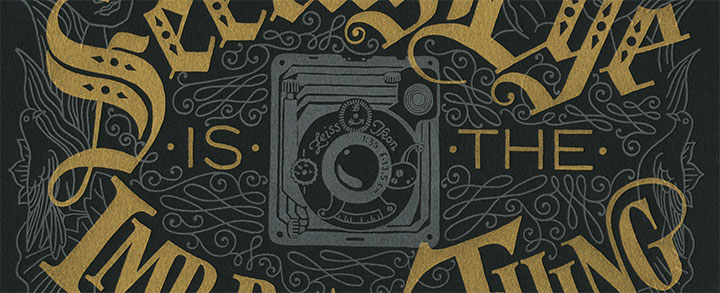
March 3rd, 2014
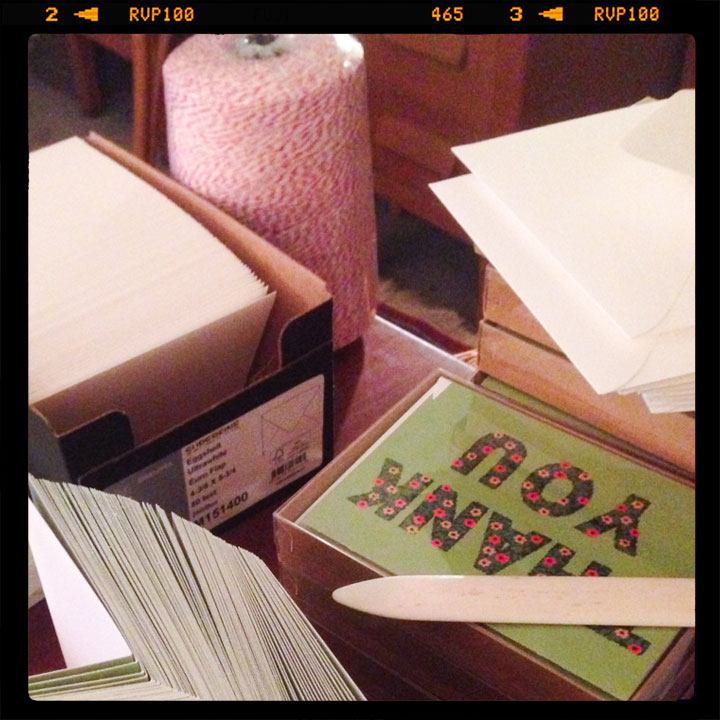
I’m working on several new things this week, including some new cards and another Dead Feminist broadside. Stay tuned!
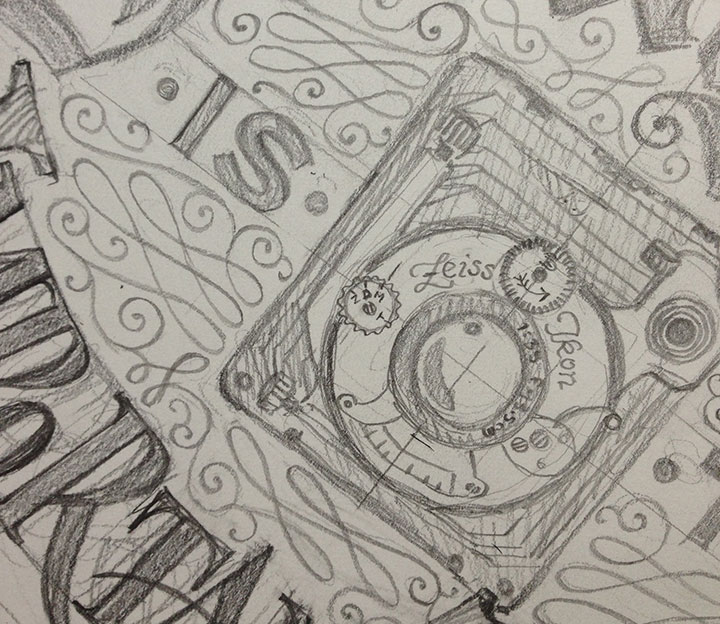
September 10th, 2013
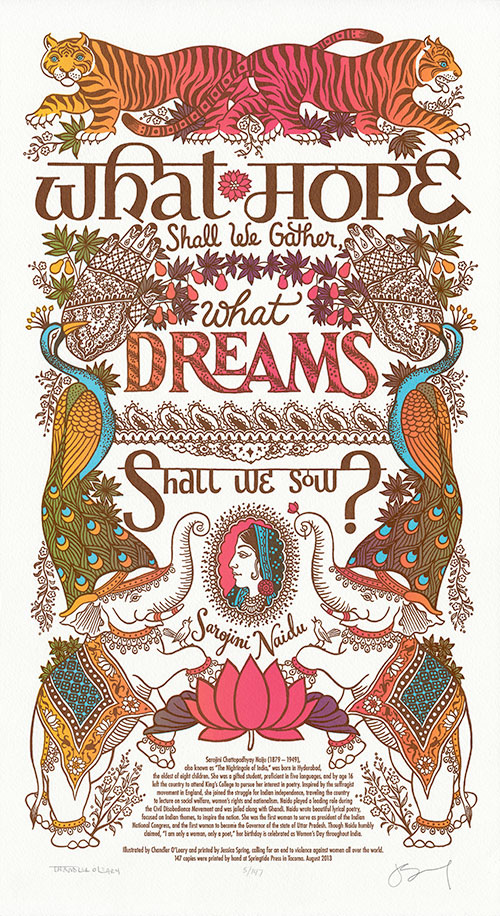
As the school year begins again and the pace of life quickens, the easy pace of summer has made way for a season of bustling, planning, and dreaming of times ahead. Yet worldwide, over and over again, the plans and dreams of so many women and girls are cut short by violence. In light of recent high-profile crimes halfway around the world, Jessica and I though it was high time we spoke up. This time we drew inspiration from the Nightingale of India:
What hope shall we gather, what dreams shall we sow? — Sarojini Naidu
“Nightsong” honors the hopes and dreams of women and girls in every culture—in defiance of the world’s dangers. The illustration depicts a lush dream menagerie printed in bright, exotic hues. Tigers, peacocks, elephants and nightingales stand sentinel around our heroine, surrounded by detailed paisleys and florals drawn in the style of Indian mehndi designs.

To make this print more dreamlike, we decided to throw a tricky technique called split-fountain printing into the mix—or “rainbow roll,” for short.
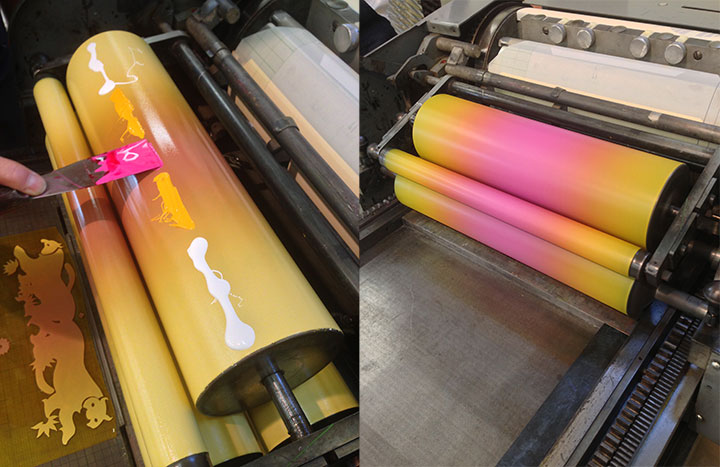
A split fountain is extremely difficult to control (advanced Eagle Scout printing here, folks), but the results are so lovely that it’s absolutely worth the effort. As an added bonus, we were careful to keep our inks translucent—so when we registered the second color, that mixed the colors even further, giving us an entire rainbow spectrum with just two passes on press.

I should add, though, that while we love printing with a rainbow roll, the process is completely unpredictable, and the finished prints are far from uniform. So rather than an edition of absolutely identical broadsides, we ended up with a beautiful range of yellows, oranges, pinks and even reds, that vary from print to print. So my scans here are representative of the edition in general, but no two prints are exactly alike (so if you order a print, please allow for some slight variations from what you see here).
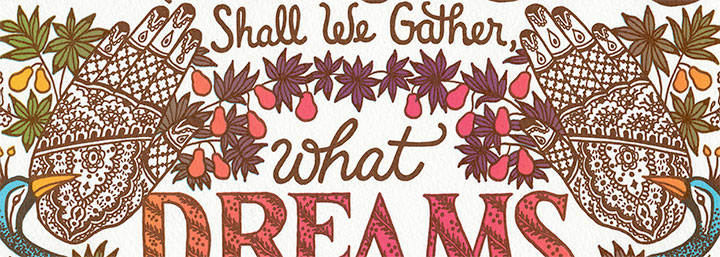
To help restore hope to victims and in honor of our dreams for the future, a portion of our proceeds will be donated to Take Back the Night. In order to create safe communities, Take Back the Night seeks to end sexual assault, domestic violence, dating violence, sexual abuse and all other forms of sexual violence.
• • • • • • • • • • • • • • • • • • • • • • • • • • • • • • • • • • • • • • • • • • • • • • • • • • • • • • • • • • • •
Nightsong: No. 18 in the Dead Feminists series
Edition size: 147
Poster size: 10 x 18 inches
Printed on an antique Vandercook Universal One press, on archival, 100% rag (cotton) paper. Each piece is numbered and signed by both artists.
Colophon reads:
Sarojini Chattopadhyay Naidu (1879 – 1949) — also known as “The Nightingale of India” — was born in Hyderabad, the eldest of eight children. She was a gifted student, proficient in five languages, and by age 16 left the country to attend King’s College to pursue her interest in poetry. Inspired by the suffragist movement in England, she joined the struggle for Indian independence, traveling the country to lecture on social welfare, women’s rights and nationalism. Naidu played a leading role during the Civil Disobedience Movement and was jailed along with Gandhi. Naidu wrote beautiful lyrical poetry, focused on Indian themes, to inspire the nation. She was the first woman to serve as president of the Indian National Congress, and the first woman to become the Governor of the state of Uttar Pradesh. Though Naidu humbly claimed, “I am only a woman, only a poet,” her birthday is celebrated as Women’s Day throughout India.
Illustrated by Chandler O’Leary and printed by Jessica Spring, calling for an end to violence against women all over the world.
UPDATE: poster is sold out. Reproduction postcards available in the Dead Feminists shop!
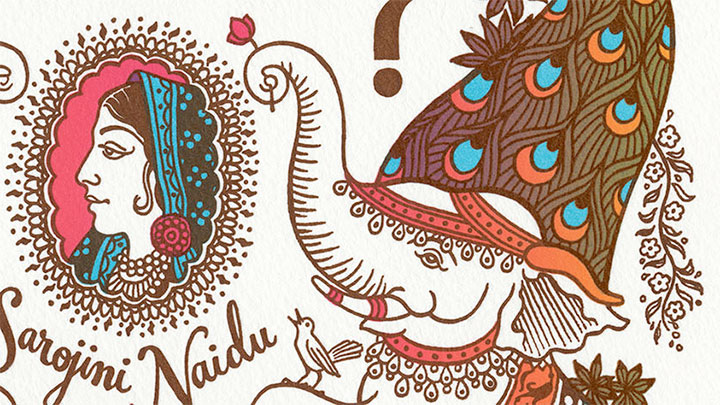
August 14th, 2013
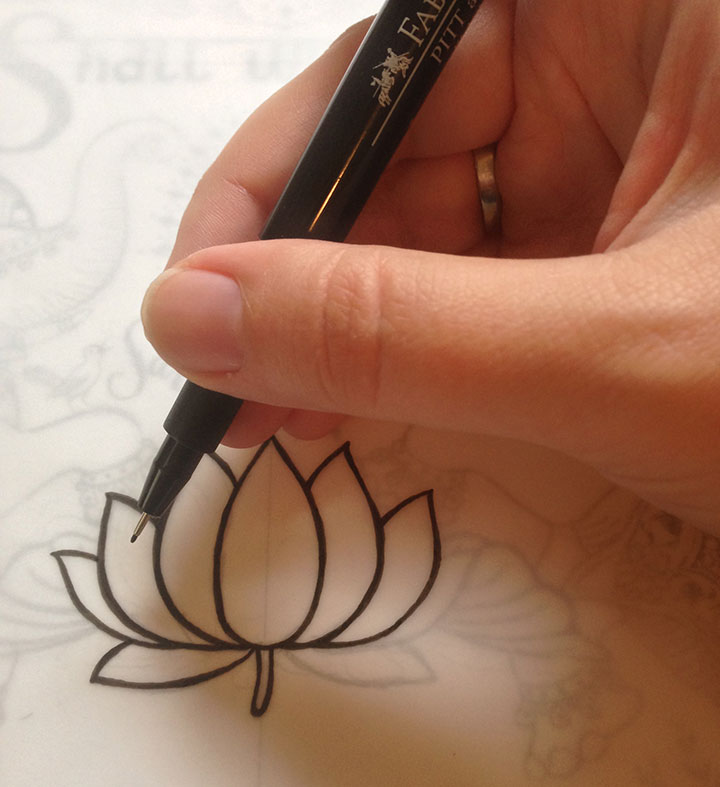
Jessica and I are hard at work on the next Dead Feminist poster—I’m inking flowers and separating colors this week, and then we’ll be on press before you know it. Look for more in the coming weeks…
February 28th, 2013

This has not been an easy post to write—and yet in a way it’s been writing itself over and over again, for years now. To be honest, Jessica and I designed this broadside months ago, and planned to release it shortly after last year’s theater shooting in Aurora, CO. Other projects got in the way, and then the 2012 election persuaded us to table the piece for the time being.
We should have known: until there’s serious change in our society, this subject will always be hatefully relevant.
So here we are again, on the heels of yet another rash of terrible violence. But this time feels different—not only because of the sheer horror of the Newtown tragedy, but because at last, our country is having the conversation it needs to have.
At the center of the debate is the precarious balance of right and responsibility—and here’s where I need to keep from shooting my mouth off. I’ve written and deleted a hundred sentences about Jessica’s and my personal thoughts on the subject—but I have a feeling you can already guess what they are. And we also recognize that our beliefs represent just one side of our divided culture. So the thought of pontificating just wearies and saddens us; we’d much rather focus on how we might move forward, together.
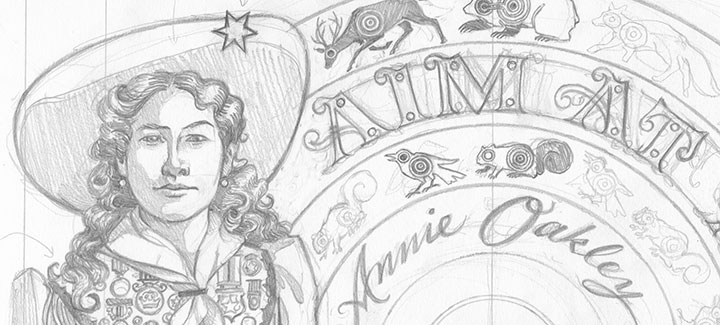
For us, that meant starting with an attempt to comprehend the other side of the debate. So in hoping to understand the love of guns many in our country share, we looked to legendary sharpshooter Annie Oakley, whose words pierce the heart of the matter:
Aim at a high mark, work for the future.

This piece is a stark, steely contrast to the bright colors and detailed embellishments of the rest of the series. Annie stands her ground beside a blazing metallic bullseye, representing the golden target of sanity amid the scatter-shot opinions and half-cocked sniping of those on the extremist fringes. And let me tell you: there’s real gold in that ink. Jessica mixes her own formula—maybe it’ll shine all the brighter, and help steady our collective aim.
• • • • • • • • • • • • • • • • • • • • • • • • • • • • • • • • • • • • • • • • • • • • • • • • • • • • • • • • • • • •
Gun Shy: No. 17 in the Dead Feminists series
Edition size: 151
Poster size: 10 x 18 inches
Printed on an antique Vandercook Universal One press, on archival, 100% rag (cotton) paper. Each piece is numbered and signed by both artists.
The edition number we choose for each print in our series is always significant in some way—whether we call attention to it or not. In the case of Gun Shy, we’ve created an edition of 151 prints to represent each person injured or killed in a shooting rampage in 2012. In light of that sobering number, we’ve chosen to donate a portion of our proceeds to Demand A Plan. A campaign of Mayors Against Illegal Guns, Demand a Plan is a national, bipartisan coalition working to make America’s communities safer by keeping illegal guns out of dangerous hands.
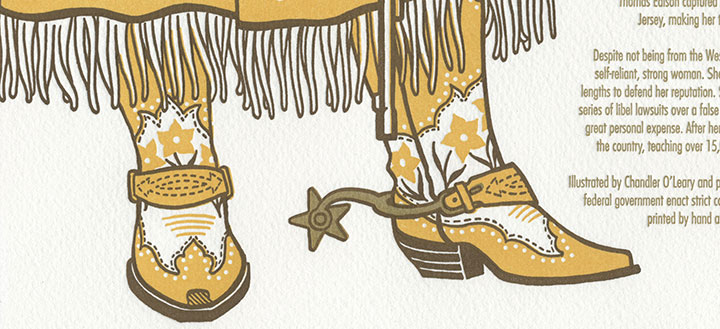
Colophon reads:
Annie Oakley (1860 – 1926) was born Phoebe Ann Mosey (or Moses) near Greenville, Ohio. Her Quaker parents raised seven children on their farm until Annie’s father was caught in a blizzard and succumbed to pneumonia. By age ten, Annie was sent to the poor farm, then to live with an abusive family for several years. She escaped back to her mother’s home, taught herself to shoot a rifle, and quickly paid off their mortgage by selling game. In 1875 Annie defeated well-known marksman Frank Butler in a shooting contest — and married him shortly afterward. Annie became Butler’s assistant in his sharp shooting show, but as audiences clearly preferred Annie, the two soon switched roles. Annie was a curiosity, dressed in a homemade costume that modestly covered her petite frame but also allowed her to shoot with athletic grace. The couple joined Buffalo Bill Cody’s Wild West show, where Annie performed for 17 years, traveling to New York, Paris and London. Upon seeing her shoot the wick off a burning candle, the famous Chief Sitting Bull adopted Annie, bestowing the nickname “Watanya Cicilla” (Little Sure-Shot). In 1894 Thomas Edison captured her performance on film at his studio in New Jersey, making her the first cowgirl to appear in a motion picture.
Despite not being from the West, Annie defined our notion of a cowgirl as a self-reliant, strong woman. She advocated for equal pay, and went to great lengths to defend her reputation. She challenged William Randolph Hearst in a series of libel lawsuits over a false newspaper story, winning 54 of 55 cases at great personal expense. After her retirement in 1913, Annie continued to tour the country, teaching over 15,000 women how to use firearms responsibly.
Illustrated by Chandler O’Leary and printed by Jessica Spring, demanding that our federal government enact strict controls to end gun violence.
Available now in the Dead Feminists shop.
November 14th, 2012
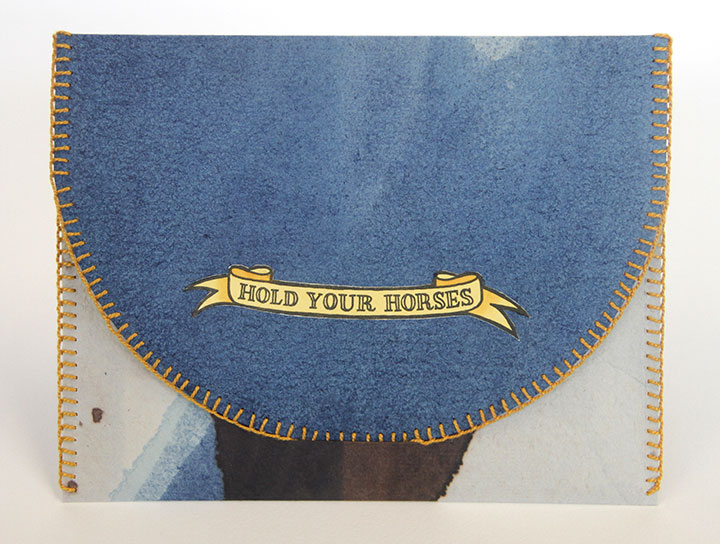
I’m pleased to present my latest artist book, Hold Your Horses.
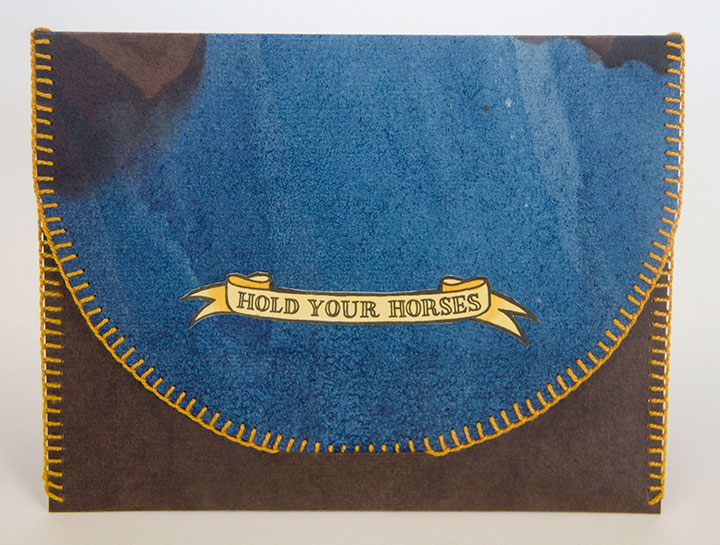
The book consists of a hand-bound portfolio (in various one-of-a-kind colors) that…well..holds some horses.
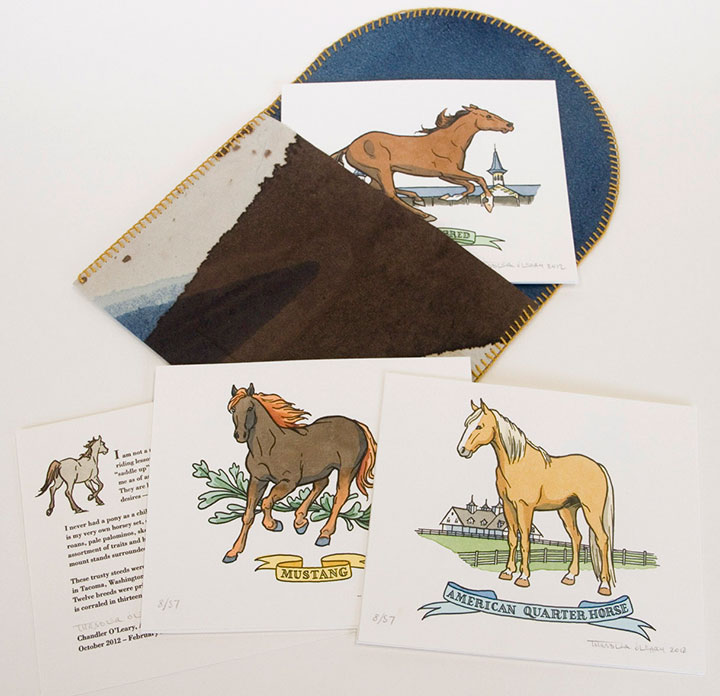
I figured it was only a matter of time before I did another print set like I did with the birds.

This time, though, I picked my favorite equine breeds,
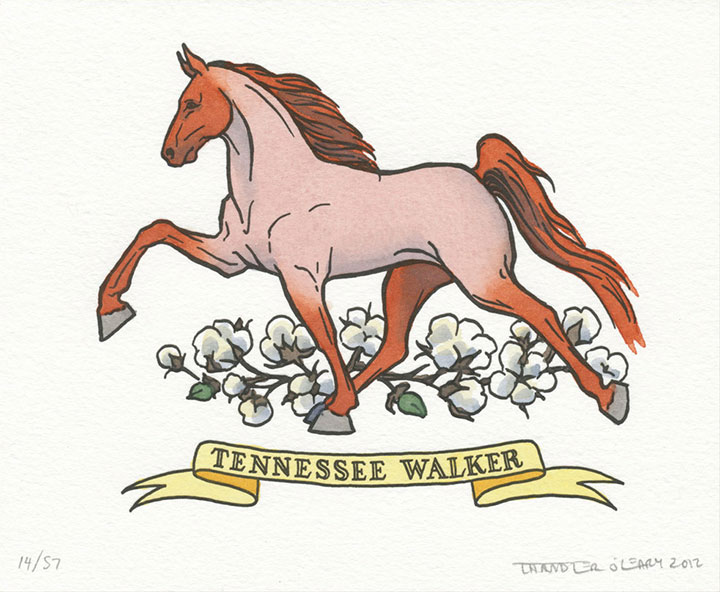
took the opportunity to push the envelope of what hand-coloring could do,
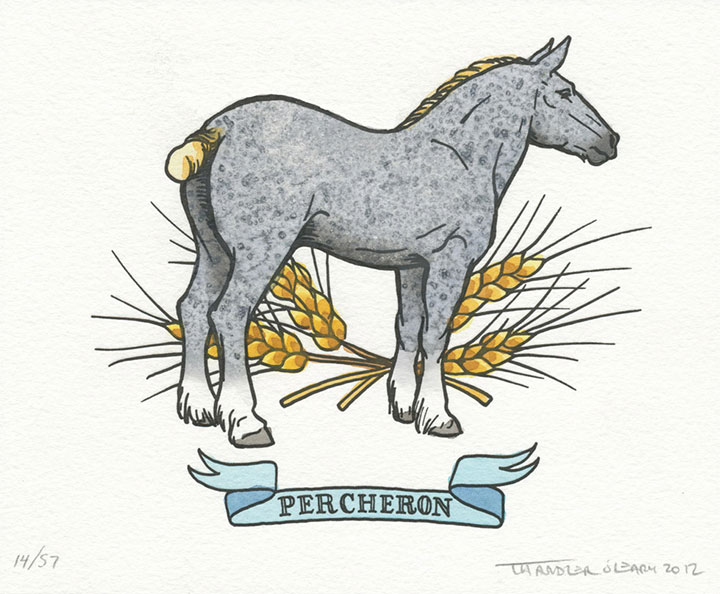
and even experimented with some wacky painting techniques.
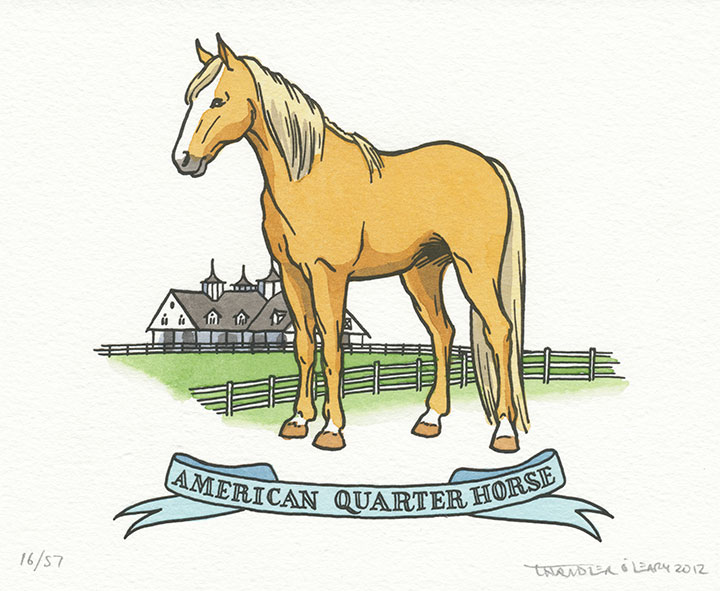
I’m really happy with how these turned out, and I can’t wait to show them off at Codex in February!
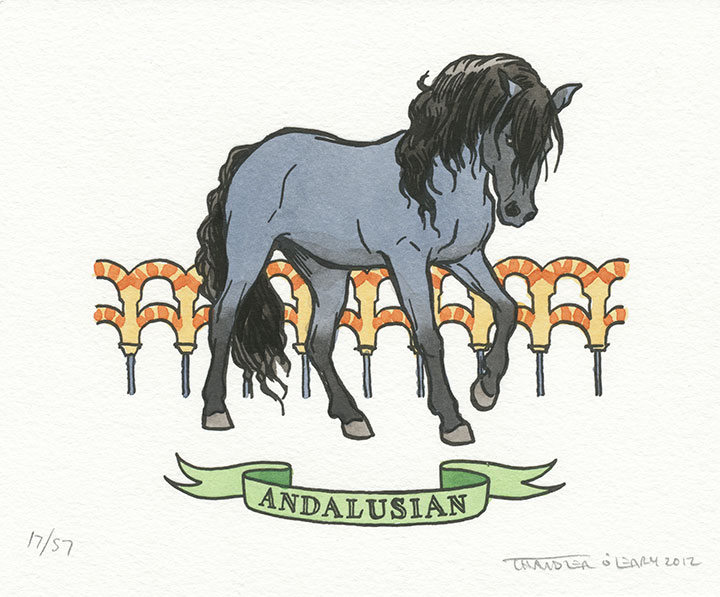
Colophon reads:
I am not a member of the horsey set. I grew up far too poor for riding lessons, and I can’t claim ever to have used the phrase “saddle up” in the literal sense. Yet horses are as much a part of me as of any American who ever looked westward in wonder. They are living symbols of the wildness that still infuses our deepest desires—even if they no longer permeate our everyday culture.
I never had a pony as a child, but now I can boast a round dozen. Enclosed here is my very own horsey set, displayed in an equine rainbow of dapple grays, strawberry roans, pale palominos, skewbald bays and rich chestnuts. This assembly gathers an assortment of traits and histories to tell the story of our fascination with horses. Each mount stands surrounded by the trappings of its trade or the symbols of its origins.
These trusty steeds were letterpress printed and individually hand-painted in Tacoma, Washington—at the very end of a frontier founded on horsepower. Twelve breeds were printed in an edition of 57 impressions apiece; the entire herd is corraled in thirteen saddle-bag sets.
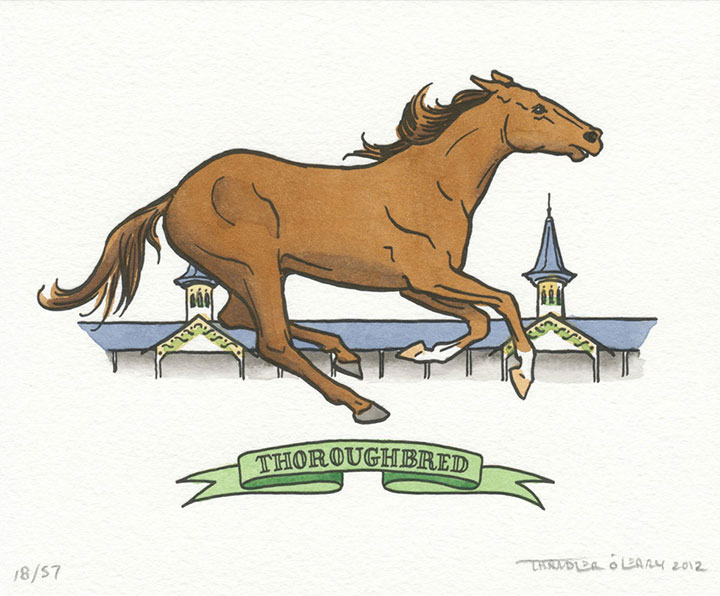
UPDATE (May 2014): a Hold Your Horses set is now part of the permanent collections at both the Phoenix Public Library and the University of Virginia Library! So if you’re local to either of those places, you can go check them out in person!
You’ll find individual horse prints in the shop.
Giddy up!

November 5th, 2012
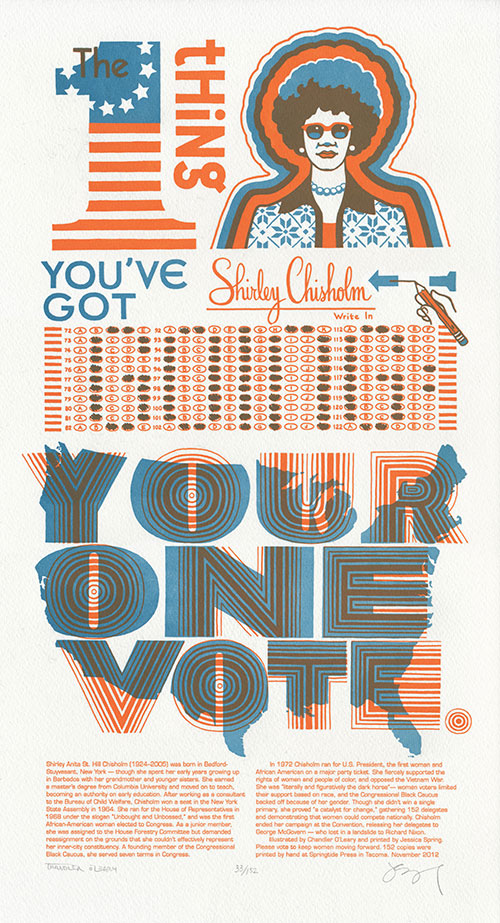
If you have any sort of link to the outside world (television, radio, internet access, newspaper, mailbox), chances are you’ve been unable to escape this year’s deluge of advertising, chatter and glossy-printed recycling fodder—all centered around this coming Tuesday. It’s enough to have even four-year-olds throwing up their hands in frustration. Jessica and I, however, have spent many hours sifting through election material—1972 election material, I mean. To remind us of what’s really important this year (and every year), we turned to the woman who help paved the way for our current President.
The one thing you’ve got going: your one vote. —Shirley Chisholm
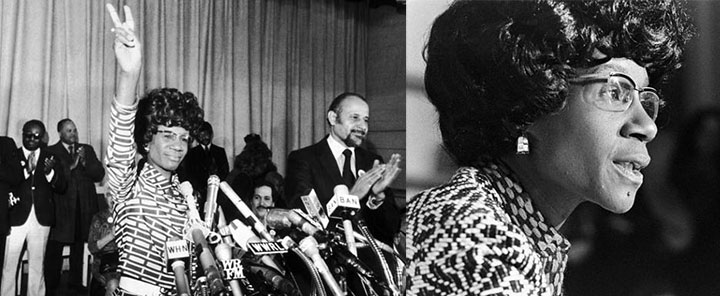
Shirley Chisholm was one of fifteen Presidential candidates in 1972. It was a volatile time: the Vietnam War was the center of public discord; movements for civil rights and gender equality were major issues around the western world; and the race came on the heels of the 1968 race—one of the bloodiest election years in American history.
Shirley knew she was a long shot; she even referred to herself as “literally and figuratively the dark horse.” Yet she also knew that to run for President, all that was required was to be a natural-born U.S. citizen of at least 35 years of age. There was nothing in there about being male or Caucasian—and as a member of the U.S. House of Representatives, she was at least as qualified as her fellow candidates. So she ran, because it was her right, and because she knew that if she played it smart and started winning delegates, she’d have some power to leverage.
Shirley sought to create a truly representative government. Rather than a cookie-cutter set of interchangeable politicians running the country, she envisioned an America where each region, economic sector and ethnic group elected one of its own to office. She wanted to see a woman heading the Department of Education & Welfare; a Native American in charge of the Department of the Interior. And as a freshman Congresswoman she was assigned to the House Forestry Committee but refused to serve—how would forest stewardship or agricultural bills represent New York’s inner-city 12th Congressional District?
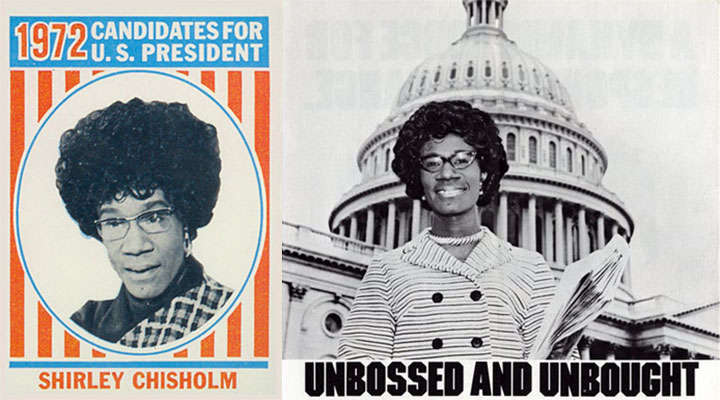
She also saw her office as an opportunity to encourage women—especially women of color—to get involved in politics. Every member of her staff was a woman, half of them African-American. To say the least, her very presence made her fellow legislators nervous—and on top of everything else, she was probably the only woman of color in the whole country who made the exact same salary as her white male colleagues. (Heck, for people like Yvette Clarke or Barbara Lee, that’s probably still true for the most part. How depressing is that?)
On the national political stage, however, her race and gender were two strikes against her. She gathered support from the National Organization for Women, but when the time came for NOW to officially endorse a candidate, their squeamishness over the possibility of a black nominee overcame their lip service. And the Black Congressional Caucus, of which Shirley was a founding member, threw her under a bus because they couldn’t bring themselves to support a female candidate. To me, that’s the most interesting thing—Shirley Chisholm always said she faced far more discrimination over her gender than the color of her skin.
Still, though she had to battle opposition and prejudice from all sides, she worked to bring people of all stripes together. When her opponent George Wallace (yes, that George Wallace—Mr. “Segregation Now, Segregation Tomorrow, Segregation Forever”) was wounded in an assassination attempt, Shirley visited him in the hospital. They were the ultimate Odd Couple: years later Wallace used his clout among Southern congressmen to help Shirley pass a bill giving domestic workers the right to a minimum wage.
In the end, though she gathered 152 delegates, she knew she’d never snag the Democratic nomination. So she conceded to George McGovern—who went on to win just one state (Massachusetts) in the 1972 Presidential election. Take a look at the electoral college map for that year:
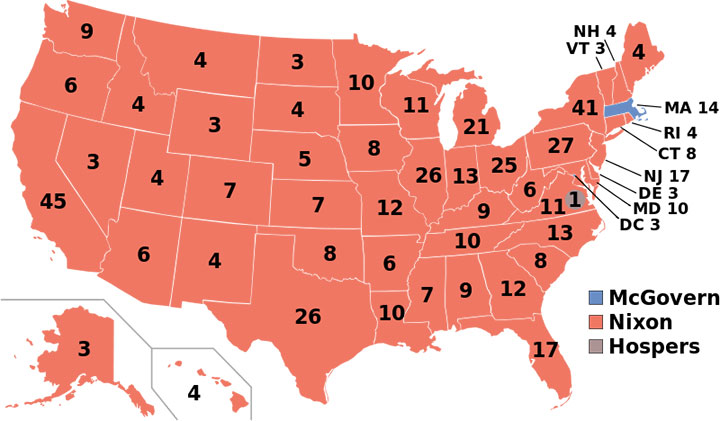
That’s a whole lotta red.
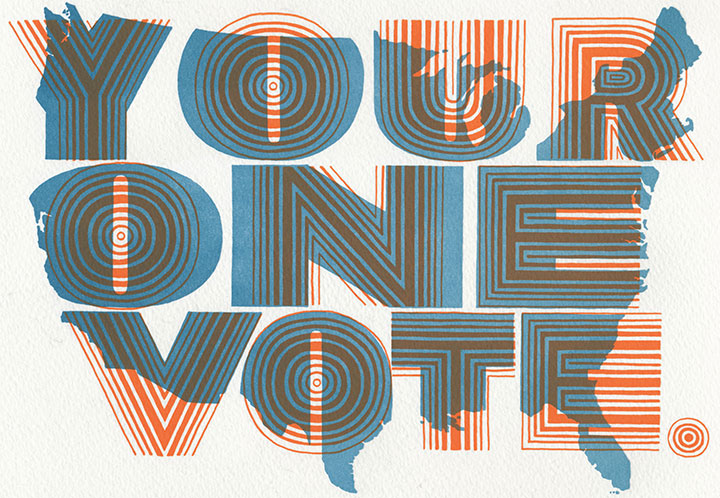
And since this election season marks the fourth anniversary of our series, that map was the starting point for Keep the Change, our new Dead Feminist broadside. I redrew the map in blue, and from there we crafted a period homage to Shirley’s impeccable style and substance.
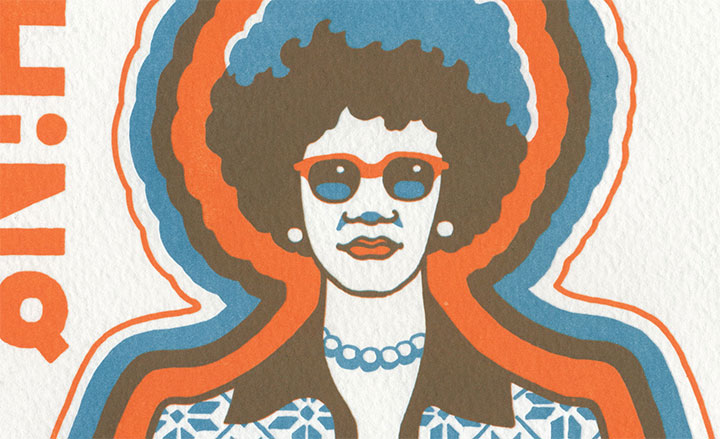
The 12th Congressional District was one of the areas hardest hit last week by Hurricane Sandy. While the immediate recovery efforts in the city are crucial, we also recognize the importance of serving a community long after the disaster relief efforts have ended. So to help continue Shirley’s long-term service to her home city, we’ll be donating a portion of our proceeds to Bedford Stuyvesant Restoration, the nation’s first non-profit community development corporation. Restoration partners with residents and businesses to improve the quality of life of Central Brooklyn by fostering economic self sufficiency, enhancing family stability, promoting the arts and culture and transforming the neighborhood into a safe, vibrant place to live and work.
In the meantime, let’s do what Shirley did best—cast our vote, and keep fighting the good fight.
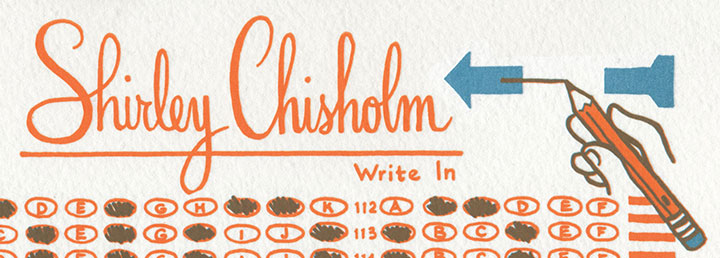
• • • • • • • • • • • • • • • • • • • • • • • • • • • • • • • • • • • • • • • • • • • • • • • • • • • • • • • • • • • •
Keep the Change: No. 16 in the Dead Feminists series
Edition size: 152
Poster size: 10 x 18 inches
Printed on an antique Vandercook Universal One press, on archival, 100% rag (cotton) paper. Each piece is numbered and signed by both artists.
Colophon reads:
Shirley Anita St. Hill Chisholm (1924–2005) was born in Bedford-Stuyvesant, New York — though she spent her early years growing up in Barbados with her grandmother and younger sisters. She earned a master’s degree from Columbia University and moved on to teach, becoming an authority on early education. After working as a consultant to the Bureau of Child Welfare, Chisholm won a seat in the New York State Assembly in 1964. She ran for the House of Representatives in 1968 under the slogan “Unbought and Unbossed,” and was the first African-American woman elected to Congress. As a junior member, she was assigned to the House Forestry Committee but demanded reassignment on the grounds that she couldn’t effectively represent her inner-city constituency. A founding member of the Congressional Black Caucus, she served seven terms in Congress.
In 1972 Chisholm ran for U.S. President, the first woman and African American on a major party ticket. She fiercely supported the rights of women and people of color, and opposed the Vietnam War. She was “literally and figuratively the dark horse”— women voters limited their support based on race, and the Congressional Black Caucus backed off because of her gender. Though she didn’t win a single primary, she proved “a catalyst for change,” gathering 152 delegates and demonstrating that women could compete nationally. Chisholm ended her campaign at the Convention, releasing her delegates to George McGovern — who lost in a landslide to Richard Nixon.
Illustrated by Chandler O’Leary and printed by Jessica Spring. Please vote to keep women moving forward.
Available now in the Dead Feminists shop!
November 1st, 2012
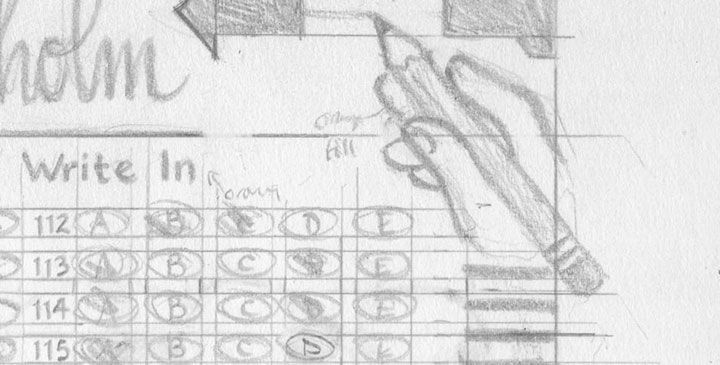
Our pencils are sharp, and our presses are fired up. Jessica and I are churning out our next candidate for Dead Feminist, and she’ll be on the ballot next week. You can catch her online then, or if you’re local, see her first at this weekend’s Studio Tour. Both Jessica and I will be open both Saturday and Sunday, as usual—more info and maps/directions here.
August 22nd, 2012
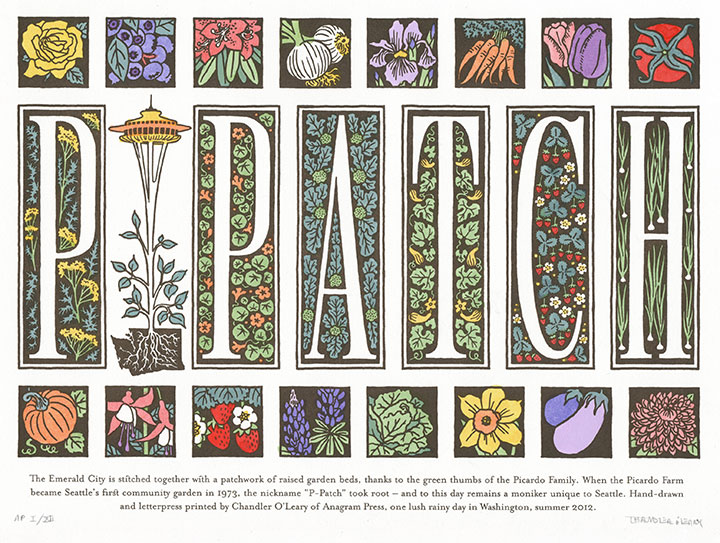
A couple of months ago I was asked to create a letterpress broadside for a collaborative print portfolio for a show in Asheville, put together by the Ladies of Letterpress. The theme was Expanding Communities—beyond that, we could do anything we wanted. So I focused on a unique element of Seattle’s community: the P-Patch.
A P-Patch is a community garden like any other—and completely unlike any other. The name comes from the Picardo family, who converted their farm into the city’s first truly communal garden in the 1970s. So to this day, if you life in Seattle, you tend your p-patch, not your garden plot. That just charmed the heck out of me, and I wanted to create a tribute to it.
P-Patch is completely hand-lettered, as well as hand-painted with watercolor, in homage to the hard work required to maintain a thriving garden. Many thanks to the Ladies of Letterpress gals for inviting me to be a part of the portfolio—I can’t wait to see what everyone else came up with!

![Chandler O'Leary [logo]](https://chandleroleary.com/wp-content/themes/chandleroleary/images/logo.png)















































